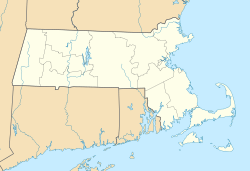Cambridge Common facts for kids
Quick facts for kids |
|
|
Cambridge Common Historic District
|
|

View of the Cambridge Common, ca. 1808-09, with Harvard College on the left and Christ Church on the right.
|
|
| Location | Roughly SE of Waterhouse St., bordered by Garden St. and Massachusetts Ave., Cambridge, Massachusetts |
|---|---|
| Area | 8.5 acres (3.4 ha) |
| Built | 1770 |
| Sculptor | Anne Whitney, et. al. |
| Architectural style | Greek Revival, Federal |
| MPS | Cambridge MRA |
| NRHP reference No. | 87000499 |
| Added to NRHP | January 26, 1987 |
Cambridge Common is a public park in Cambridge, Massachusetts. It is a special place called a National Historic Landmark. The park is close to Harvard Square and borders parts of Harvard University. At the north end of the park, you can find a large playground. The Cambridge Department of Public Works takes care of the park.
Contents
What is Cambridge Common?
Cambridge Common is a large, open green space. It is a place where people can relax and play. The park has been important for hundreds of years. It has seen many historical events. Today, it is a popular spot for both locals and visitors.
A Look Back: History of the Common
How the Common Started
Long ago, during the colonial period, Cambridge Common was a big open field. Farmers used it as a pasture where their animals could graze. It was also a training ground for soldiers. The Common was much larger back then. It stretched from what is now Linnaean Street all the way south to Harvard Square.
George Washington and the Famous Elm
There is a well-known story about George Washington. People say he took command of the Continental Army here. This happened under a special tree called the Washington Elm. However, historians have found that this ceremony probably did not happen at the Common. It is a popular legend, though!
Changes Over Time
The Common you see today was not fenced in until 1830. During World War I, buildings were put up on the Common. The Navy Department built barracks for its Radio School there.
A Place for Public Gatherings
Cambridge Common has always been a place for people to meet. Groups would gather here before marching to Boston Common. This happened during important protests. For example, people protested for Civil Rights. They also protested against the Vietnam War. It shows how important the Common has been for public expression.
A Fun Fact from a Famous Actor
Did you know that famous actor Matt Damon once played football here? He recalled a time in the mid-1980s. His friend Ben Affleck helped him in a fight during a game on the Common.
Monuments and Memorials
Cambridge Common is home to several important statues and plaques. They help us remember key moments and people in history.
Remembering George Washington
A special plaque marks the spot where the Washington Elm once stood. This is the tree where the legend says Washington took command. Nearby, you can see three bronze cannons. There are also plaques for Henry Knox and Tadeusz Kościuszko. These were important figures in the American Revolution.
The Puritan Statue
In the northeast part of the Common, you will find a statue. It is called the Statue of John Bridge. It is also known as The Puritan. This statue was created by Thomas Ridgeway Gould.
Civil War Memorial
Slightly southeast of the center, there is a memorial for the American Civil War. It has a statue of Abraham Lincoln in a covered area. On top of the memorial, there is a statue of a soldier. This memorial honors those who fought in the war.
Irish Famine Memorial
Cambridge Common also has an Irish Famine Memorial. This memorial was dedicated on July 23, 1997. The President of Ireland, Mary Robinson, was there. About 3,000 people attended the event. The memorial sculpture was made by Maurice Harron. He is a sculptor from Derry, Northern Ireland. There is a similar memorial in downtown Boston.
Gallery
Images for kids








